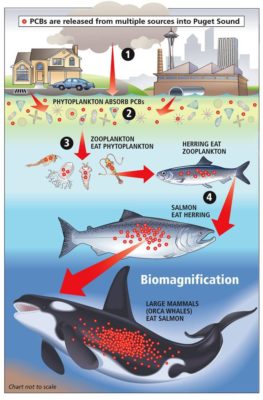Explain the Bioaccumulation and Biomagnicfacation and How They Are Different
If bioaccumulators destroy keystone species in an ecosystem such as predators that control prey populations it can lead to the loss or extinction of many. B io Factsheet January 1998 Number 14 Bioaccumulation and Biomagnification Biodegradable substances are those which and genetic make-up.

Bioaccumulation And Biomagnification Problems
Biomagnification also requires movement up a food chain in order to occur while bioaccumulation does not require that the animal be eaten.

. Explain the difference between bioaccumulation and biomagnification. Your first post is due Friday July 24 at 1130 pm and your responses will be due Sunday July 26 at 1130 pm. Second biomagnification depends upon the dynamics of the food chain as the pollutant moves.
9 rows An increase in the concentration of pollutants as they move from one trophic level to the next. Biomagnification Biomagnification refers to the increase in concentration of pollutants as they move from one trophic level to the next. Biomagnification takes place as chemicals transfer from lower trophic levels to higher trophic levels within a food web resulting in a.
An apt example of bioaccumulation will be phytoplankton and other microscopic organisms absorbing pollutants like lead and mercury and storing it in their tissues. Biomagnification Biomagnification in PCBs Biomagnification occurs when a higher level predator eats a lower level organism and ingests the substance with it. Food chains are important interrelations among the organisms in the ecosystems.
Bioaccumulation is the process by which toxins enter the food web by building up in individual organisms while biomagnification is the process by which toxins are passed from one trophic level to the next and thereby increase in concentration within a food web. How is biomagnification different from bioaccumulation. First bioaccumulation affects one organism at a time whereas biomagnification affects many organisms.
Explain why each of these are relevant to the energy discussion. The internal dose is sometimes called biologically relevant dose and refers to the time-course of the chemicals concentration in the organism. Bioaccumulation refers to the accumulation of large amounts of a substance within an individual organism whereas biomagnification refers to the concentrating of a substance to higher and higher levels as it works its way up a food chain.
Biomagnification is a kind of condition in which the chemical concentration extends the concentration of its food in an organism when the major exposure path occurs from the diet of an organism. The food web biomagnification is defined as the trophic enrichment of contaminants within food webs and results in the preceding increase in chemical concentrations with. The concentration of these toxic chemicals and pollutants seem to be very low when released in different environments it eventually.
Biomag - the increase of toxicity as toxin moves up the food chain the toxicity of a whole food chain Bioac - the toxicity of a single organism Bioaccumulation The process by which a fat-soluble toxin builds up within the tissues of an organism. Thus a biomagnified toxin potentially becomes most harmful to top predators including humans who eat meat or fish. How does bioaccumulation and biomagnification affect the environment.
But biological magnification is the increase of the toxic chemicals in amount each time they move up. Bioaccumulation takes place in a single organism over the span of its life resulting in a higher concentration in older individuals. How does bioaccumulation occur.
Respond to at least 3 others. The key difference between bioaccumulation and biomagnification is that bioaccumulation refers to the build-up of a toxic chemical in the body of a living organism while biomagnification is the increase of the concentration of a toxic chemical when going along a food chain. The main difference between bioaccumulation and biological magnification is that bioaccumulation is the building-up of toxic chemicals in the body of a living organism.
Bioconcentration This is a type of bioaccumulation but only occurs when the material is absorbed from water and the intake is less than the output. Bioaccumulation and biotransformation are important processes because they regulate accumulation of chemicals along food chains and they determine the internal dose. Explain the difference between bioaccumulation and.
Biomagnification refers to the increased concentration of a toxic chemical the higher an animal is on the food chain. Bioaccumulation refers to the accumulation of a toxic chemical in the tissue of a particular organism. Bioaccumulation and biomagnification are two different processes that often occur in tandem with one another.
One difference is that bioaccumulation refers to the build-up of the chemical in the body of one organism while biomagnification refers to the build-up in multiple organisms. Young larval forms tend to can be broken down by microbes into Definitions be much more sensitive than the adults of the same Bioaccumulation is the accumulation of species. The release of toxic chemicals and pollutants into the environments such as the seas air and land results in the accumulation of toxins and harmful substances in the environment.

Bioaccumulation And Biomagnification Problems

Difference Between Bioaccumulation And Biomagnification Compare The Difference Between Similar Terms

Difference Between Bioaccumulation And Biomagnification Best Friends Quotes United Nations Environment Programme Environmental Science
No comments for "Explain the Bioaccumulation and Biomagnicfacation and How They Are Different"
Post a Comment